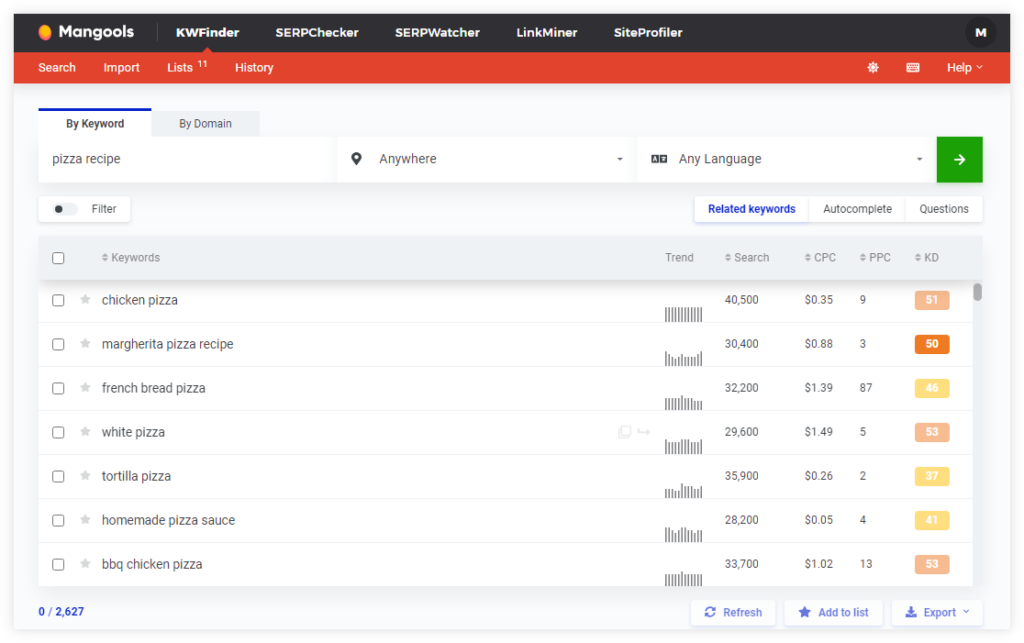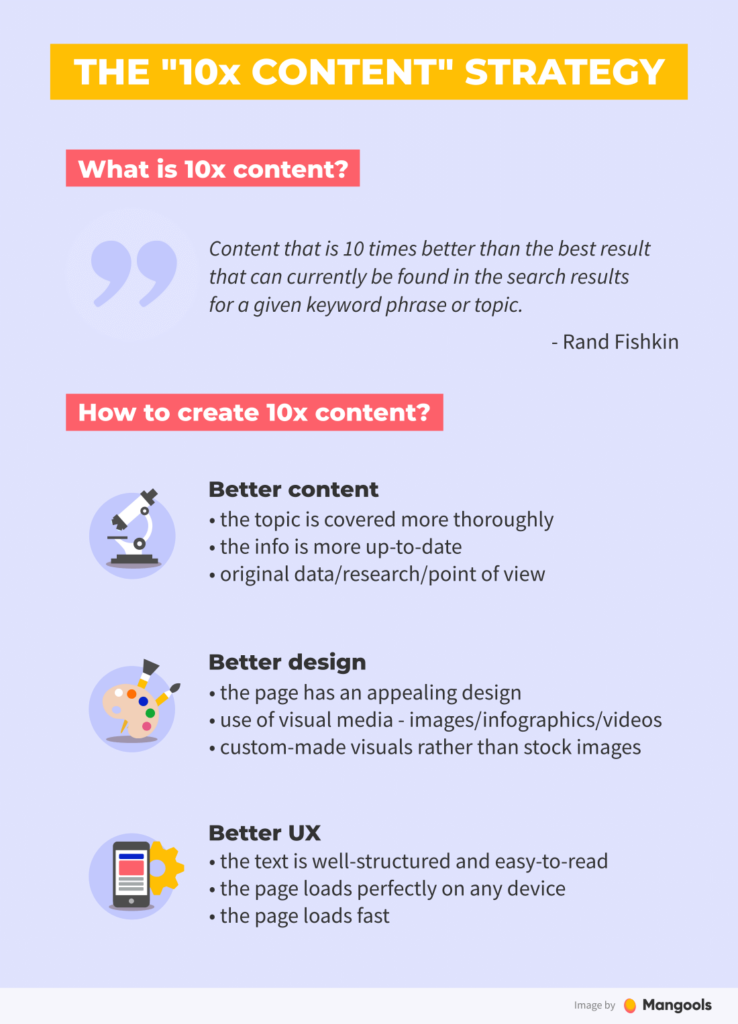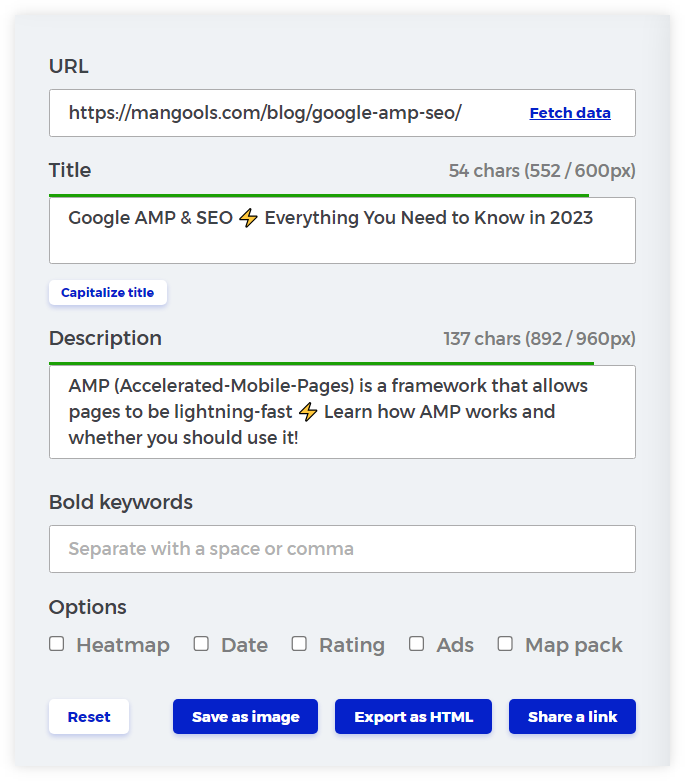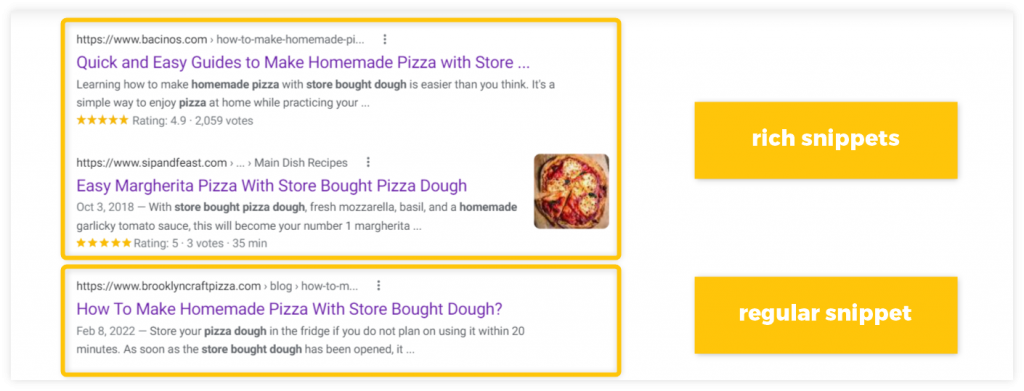Do you find your pages getting little to no organic traffic? Are you swimming in an ocean of SEO tasks, but unable to find your footing?
Then you’re in luck!
We’ve put together this easy on-page SEO checklist you can use to make your website more search engine-friendly and appealing to visitors.
So strap in and get ready to learn the best ways to optimize!
1. Identify & use relevant keywords
Anyone can throw a bunch of keywords on a page and call it a day, but that won’t get you very far on the SERP.
In order to rank well in Google, you need to find out which keywords might be relevant for your website (and target them with well-optimized, high-quality content).
To do this, you need to use tools like KWFinder – it will help you find the right keywords and show you various useful metrics about them such as search volumes, keyword difficulty, the trend of the keywords, etc.

Once you find keywords that might be relevant for you, you can use our SERPChecker tool to perform the SERP analysis – this will help you find hidden opportunities in SERPs that can make your pages rank faster and higher.
2. Create high-quality content
No matter how hard you try to optimize your pages, you won’t get very far unless you create high-quality content for them first.
If you want to outrank your competitors, you need to answer the search query and provide unique and useful content better than any of the top 10 ranking web pages for your chosen keyword.
After all, content is king.
Providing value to users and covering every aspect of the chosen topic will make Google rank your pages higher than any of your competitors.
To do this, you can use a so-called 10x content strategy – a technique that will help you to create a thorough topic coverage with original data, better design, and improve the overall user-experience on your pages:

There are many ways how you can make your content look more attractive and readable, here are some of them:
- Avoid long paragraphs: Break down content into shorter paragraphs to enhance readability.
- Create bullet points or lists: When listing information, use bullet points or numbered lists to make the content more digestible.
- Provide in-depth information: Give your readers something of value that will keep them on your page.
- Use proper spelling and grammar: Good spelling and grammar are the bedrock of good content.
- Use high-quality images: Choose clear and relevant images that complement the content.
- Include videos or infographics: These can provide a deeper understanding of the topic.
- Look at competitors for ideas: What is your competition doing, and what can you do differently or better than them?
3. Use proper headings and subheadings
Heading tags (H1, H2, H3, etc.) help users and search engines understand your content structure.
In order to properly optimize them, you have to create a logical hierarchy of your headings with H1 tag (as a main headline) at the top of the page, representing the main topic of the page, and H2s and H3s (or even H4s) as supporting headings that will structure your content into individual sections.
Here’s what a proper heading architecture can look like:

When it comes to heading optimization, make sure to include relevant target keywords to some of them – but naturally.
4. Add useful internal links
You’ve noticed by now that we’ve included various useful links on this page.
Internal links are not only great for helping users to navigate to other useful pages on your website, but also to improve the crawlability and spread the PageRank evenly into all places on your site.
Here are a few good SEO practices that you should keep in mind when it comes to internal links:
- Develop a linking structure: Plan a logical linking structure. Typically, this involves linking from your high-authority pages to lower-authority pages that you want to boost.
- Use descriptive anchor texts: The clickable text in a hyperlink (anchor text) should be relevant to the linked page. Avoid using generic terms like “click here“.
- Link deep: Avoid linking only to your homepage or “contact us page”. The idea is to direct users deeper into your site to relevant and helpful content.
- Don’t over-link: Although there’s no official number, keeping the links on any given page to a reasonable number is good practice for usability, accessibility, and SEO.
- Update internal links: Regularly review and update your internal links to make sure they’re still relevant, especially if you frequently add new content.
5. Optimize your images
Image alt text is a description of pictures on your website – its primary purpose is to help both visually impaired readers and search engines understand the images on your pages.
For example, you might have a photo of a puppy playing in a field. Your alt text would probably be something like ‘yellow labrador running in grass’. Use these checklist items to make the best possible image alt texts:
- Keep it short: Aim to keep the alt text description between 50-125 characters.
- Describe the image accurately: Use the simplest and clearest language to accurately describe the image. If the image contains text, include that text in the alt attribute.
- Use keywords naturally: If it’s natural to do so, include relevant keywords in the alt text, but don’t force or overstuff them!
- Avoid redundancy: Don’t use phrases like “image of” or “picture of” in the alt text, as screen readers already identify the content as an image.
- Provide context: Write alt text that fits the context of the page and the content surrounding the image.
- Use empty alt text for decorative images: If an image is purely decorative and doesn’t provide essential information, use an empty alt attribute (alt=””) to signal to screen readers that the image can be skipped.
- Don’t forget thumbnails and icons: Thumbnails, icons, and other functional images should also have appropriate alt text that describes their purpose or function.
- Regularly check and update alt text: Regularly review and update the alt text to ensure that it continues to be relevant, especially if the content on the page changes.
6. Consider linking to external websites
Linking to external websites may add credibility to your content, improve the user experience, and positively impact your site’s ranking with search engines.
Both internal and external links work together to create a more engaging and informative experience for your readers – or as John Mueller (Google Search Advocate) stated:
“Linking to other websites is a great way to provide value to your users. Oftentimes, links help users to find out more, to check out your sources, and to better understand how your content is relevant to the questions that they have.”
When it comes to outbound links, there are a few things that you should always consider before you put them on your pages:
- Identify relevant and authoritative sources: Link to websites that are reputable and relevant to your content. This builds credibility and can signal to search engines that your content is well-researched.
- Avoid linking to low-quality or spammy sites: Linking to poor-quality websites can harm your SEO. Always make sure that the sites you’re linking to are trustworthy and of high quality.
- Open external links in a new tab: You don’t want to send visitors away, right? Keep visitors on your original page while allowing them to explore the linked content in a new browser tab.
- Check for broken external links: Just like with internal linking, check that all of your external links work, too.
7. Optimize your title tags
Creating and optimizing title tags is one of the fundamental parts of on-page optimization since they serve as a ranking signal for Google as well as influence the appearance of your organic snippet in Google Search.
Here are a few important practices that you should keep in mind when writing your title tags
- Keep an optimal length – title tags should not be longer than 50 – 60 characters (otherwise they might get trimmed by Google)
- Include your focus keyword – your title tag should always contain your target keyword. It’s often the first thing a user sees on the SERP, so make it count.
- Create unique titles – try to write original and attractive title tags that will distinguish your pages from the rest of the search results in Google Search.
8. Write catchy meta descriptions
The meta description serves as a summary of a page’s content. This succinct snapshot of your content informs Google users about the purpose and content of your page.
Similarly to title tags, you should always try to:
- Keep an optimal length – Meta descriptions should not be longer than 120 – 160 characters.
- Include focus keyword – Although not necessary, having a focus keyword included in your meta description may increase the relevancy of your snippet in Google Search.
- Be unique – Each page should have a unique meta description that shortly and clearly describes the page content. I
Tip: You can prepare and check the appearance of your title tags and meta descriptions with our free SERP Simulator.
The tool will show you how your organic snippet would actually look in Google Search as well as check the length of your titles and descriptions for you.

9. Create SEO-friendly URLs
URLs play an important role in on-page optimization – not only they are used as a small ranking signal but also help users quickly navigate and understand individual pages on your website.
All your site URLs should be SEO-friendly, meaning they should be clear, concise, and descriptive, ideally containing your primary keywords.
When creating user-friendly URL slugs for your pages, you should always:
- Keep them short.
- Include your target keywords.
- Separate words in the slug with dashes
- Use only lower-case letters
10. Add structured data.
Structured data can significantly boost the CTR of your snippet in Google Search – they can improve the relevancy of your page as well as be displayed in the form of a rich result.

Google supports various types of structured data that may enhance your pages such as “Article”, “FAQ”, “Recipe” markups, etc.
Creating proper schema markups is a pretty straightforward process:
- Generate markups – you can write your schema scripts by yourself or use markup generators such as Merkle Schema Markups or Google Markup Helper.
- Test your markups – make sure to always test your schema markups with tools like Rich Result Test or Schema Markup Validator.
- Implement structured data to your website – depending on your CMS, you can either copy/paste your markups right into the web pages or use plugins to do it for your
Tip: You can use our Mangools SEO extension and see whether or not your structure data were implemented properly!

Final Thoughts
Your SEO checklist should include all the elements discussed above for the maximum benefits.
Make it a habit to regularly review and update your SEO checklist to align with changing search engine algorithms.
With careful planning, strategic execution, and continuous optimization, your website can rise in search engine rankings, increase its organic traffic, and increase its visibility.
This way, your site will not just be another drop in the digital ocean, but a prominent beacon for users and search engines alike.
